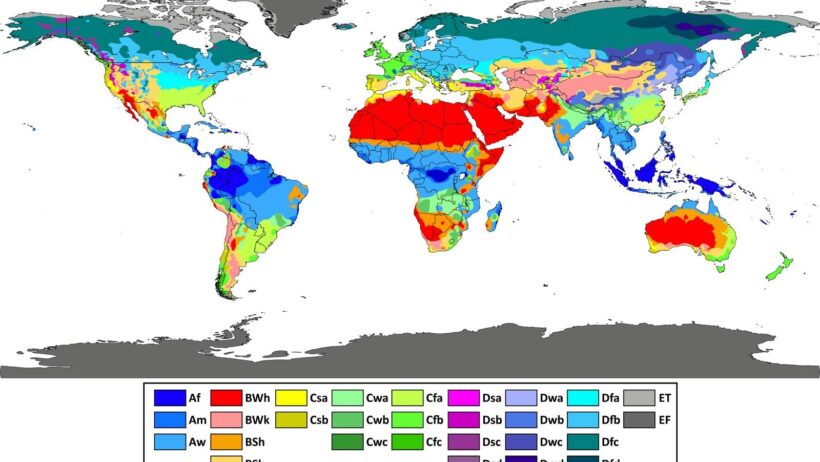Georgia, the Peach State, is renowned for its lush landscapes and bountiful agriculture, but beyond its picturesque scenery lies an intricate relationship with its climate. Particularly, Georgia finds itself nestled within the humid subtropical climate zone, a classification that influences not only the state’s ecological balance, but also agricultural practices, water resources, and even the lifestyle of its inhabitants. Understanding this climate zone is fundamental to appreciating both the challenges and opportunities it presents.
The humid subtropical climate is characterized by hot summers and mild winters, with precipitation distributed throughout the year. Georgia embodies this climatic pattern magnificently. In general, the southeastern region of the United States experiences this type of climate, largely due to its geographical positioning near warm ocean currents. The Gulf of Mexico, just to the southeast, infuses moisture-laden air, which plays a pivotal role in generating the heavy rainfall that typifies the region.
Summers in Georgia are often sweltering, with temperatures frequently soaring into the upper 90s°F (mid-30s°C). The southern cities, such as Atlanta and Savannah, witness a melange of heat and humidity that can be stifling. The humidity can elevate the heat index considerably, giving the sensation of hotter conditions. Thunderstorms are common during this season, as the warm, moist air becomes unstable and results in dramatic weather patterns, often accompanied by torrential rains.
Winter, in contrast, offers a reprieve from the intense summer heat. Temperatures typically range from the low 30s°F to the mid-50s°F (about 0°C to 15°C). However, snow and ice are rare, particularly in southern Georgia, although occasional cold snaps can send chills through the state. The climate during this season is generally mild, which allows for a diverse range of flora and fauna to thrive year-round.
Transitioning from season to season reflects the dynamic nature of Georgia’s climate. Spring and autumn are transitional periods, marked by moderate temperatures and fluctuating weather patterns. The spring heralds a reawakening of vegetation, leading to blooming wildflowers and the iconic cherry blossom displays of Macon. Conversely, fall paints the landscapes in vibrant hues of orange and red, as deciduous trees prepare for winter dormancy.
The humid subtropical climate not only shapes weather patterns but also impacts the ecological tapestry of Georgia. The state is home to a diverse array of ecosystems, ranging from coastal marshlands to mountainous regions. This biodiversity is sustained by the abundant rainfall, which replenishes rivers, lakes, and aquifers that are critical to both wildlife and human consumption. However, the implications of climate change loom large over these ecosystems. Increased temperatures and shifting precipitation patterns can lead to drought or flooding, posing risks to agriculture, water resources, and natural habitats.
Agriculture in Georgia thrives under the humid subtropical designation, producing an impressive array of crops—most notably peaches, peanuts, and cotton. The extended growing season, facilitated by temperate winters, allows farmers to cultivate multiple crops a year. However, the variability in precipitation—sometimes resulting in excessive rains or prolonged dry spells—challenges farmers to adapt their practices continually. Sustainable agriculture initiatives are vital to mitigate these challenges, ensuring that farming can be resilient in the face of climate change. Crop rotation, conservation tillage, and integrating agroecological practices can enhance soil health and water conservation.
Moreover, this climate zone plays an integral role in influencing Georgia’s cultural and recreational activities. The balmy summers attract tourists to the state’s pristine beaches, historical sites, and vibrant cities. Outdoor festivals flourish, celebrating local music, arts, and, of course, culinary delights, drawing on the state’s rich agricultural bounty. Residents and visitors alike revel in the beauty of nature, whether through hiking in the Appalachian foothills or basking in the sun at coastal retreats.
However, as the world grapples with the consequences of climate change, the humid subtropical climate is not immune to its effects. Extreme weather events, including hurricanes and severe storms, are becoming increasingly prevalent, with rising sea levels threatening coastal areas. The interplay of climate persists, demonstrating an alarming shift in typical precipitation patterns, which can lead to more severe droughts in certain regions, while simultaneously causing flooding in others. This complexity requires innovative strategies and community resilience to navigate the looming uncertainties of climate-related shifts.
In conclusion, Georgia’s humid subtropical climate encapsulates a world of ecological diversity, agricultural richness, and cultural vibrancy. Its impact stretches beyond just weather; it plays a crucial role in shaping the environment and lifestyle of its inhabitants. Exploring this climate zone illuminates the interconnectedness of human activities, environmental stewardship, and climate realities. As Georgia moves forward, embracing sustainable practices and adapting to the evolving climate will be essential for protecting its natural heritage and ensuring the well-being of future generations. This exploration of Georgia’s climatic tapestry invites both curiosity and responsibility, urging a deeper understanding of how we can coexist harmoniously with our environment.








